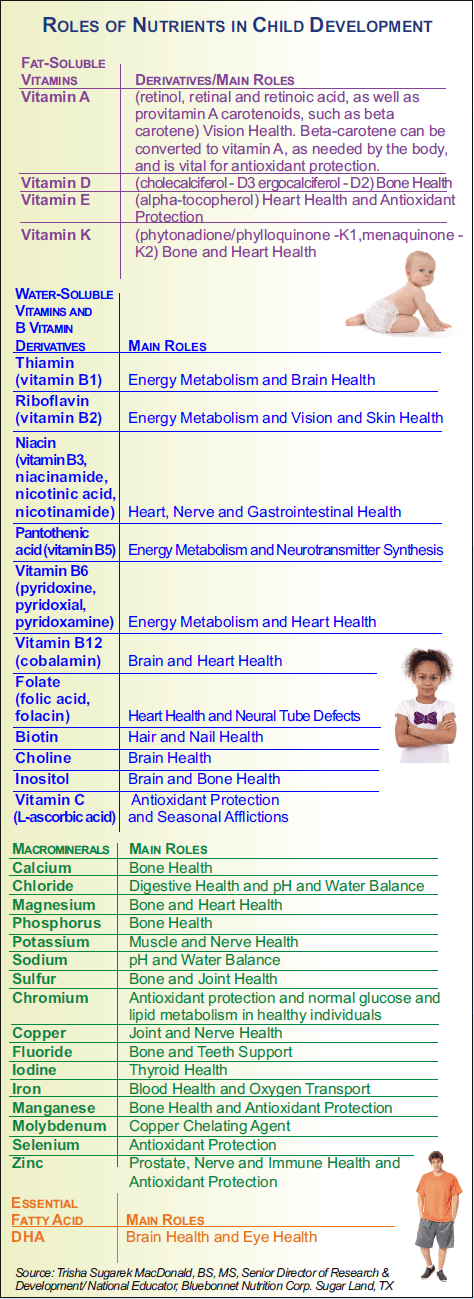It’s a different world today, and several pertinent issues currently face our babies and children. One is the childhood obesity epidemic.
It is a complex challenge, noted Audrey Ross, ND, western region educator of Hauppauge, NY-based Country Life Vitamins. Beyond nutrition, Ross says contributing factors include “a lack of opportunities for physical activity in schools, escalating food costs, less time for meal preparation, and leisure time being spent more sedentary with video games or television watching.”
The National Institutes of Health says that childhood obesity, defined as those with a body mass index of 30 or higher, may lead to early development of type 2 diabetes, hypertension, and depression and related psychological challenges, as well as higher risk in adulthood of developing arthritis, cardiovascular disease or cancer.
Bryan See, regional product manager, ExcelVite Inc., Edison, NJ, also believes childhood obesity is the most pertinent issue facing children today. He ascribes this top concern to several factors. One is parental misconceptions about their young offspring, believing that perhaps the child is too light or thin, and feeding them more. He also points to the abundance of junk food still chosen by families to eat, combined with a much more sedentary lifestyle led by children. “Obese or overweight children have a higher chance of staying obese or overweight when they grow up,” he says.
Time Pressure Leads to Poor Choices Another factor is that children tend to be picky eaters, and overcoming this with the goal of teaching healthy and clean eating is “quite the dilemma in our country,” observes Alyson Eberle, CEO of Austin, TX-based Pure Spoon. The challenge is that many parents who are busier than ever just tend to select the quick, more widely available, less expensive nutrient-empty foods and snacks for their brood — despite their knowledge of, desire and demand for much healthier options overall.
Malnutrition in modern American children, clarifies Trisha Sugarek MacDonald, BS, MS, senior director of research and development/national educator, Bluebonnet Nutrition Corp., Sugar Land, TX, typically occurs not because of the lack of food, since more than a third of American kids are overweight, but because of the lack of balanced nutritional foods, portion sizes and the overconsumption of processed/fast foods. “The most common nutrient deficiencies seen today are calcium, fiber, folate, iron, magnesium, potassium and vitamin E, and their potential consequences range if depletion is ongoing. For example, calcium, magnesium and vitamin D3 are essential for bone health; iron and folate (plus, B12) are necessary to reduce the chance for various anemias; and fiber is vital for gut health,” she explains.
Parents are also becoming more frustrated in “maneuvering the minefields” to provide their children with optimal health options in foods every day, says Murray Clarke, ND, president, founder and formulator of ChildLife Essentials, Culver City, CA. He points to the lack of nutrients supporting the growth and development in babies, infants and children caused primarily by soil that is nutrient depleted, as well as poor absorption and utilization of the nutrients that are available, higher stress levels, environmental pollutions and toxins, lack of sunshine and fresh air that all impact children’s health today.Our Children’s Lifestyle A key reason for low levels of exercise and lack of sunshine and fresh air is the almost obsessive use of electronic and digital devices (e.g., laptop, tablet, smart phone, TV). “One of the fastest-growing and under-the-radar issues is how technology could be harming children physically,” says James Johnson, brand manager Twinlab VMS, Twinlab Consolidated Corp., Boca Raton, FL.
These devices expose children’s eyes to intense concentrations of high-energy blue light, which is a very high frequency range of the visual light spectrum that damages the eyes over long durations of exposure; and exposure durations are getting longer. In adults, damage begins at approximately two hours; but it takes less time in children whose eye lenses have not yet developed a yellow film that helps adults filter out some of the blue light.
“Children and adults do have an additional layer of protection,” says Johnson. “A nutritional shield within our eyes helps filter high-energy blue light to protect the macula from damage. This shield, consisting of lutein and zeaxanthin, is worn away by our digital device usage at a much faster rate than our diets can provide these needed nutrients. Computer Vision Syndrome, the name given to these symptoms caused by long-term blue light exposure, has become the ‘tax’ paid for our modern lifestyle.”
For this reason, products that contain lutein and zeaxanthin have gained a surge of popularity. Twinlab, for example, offers a chewable (Ocuguard Blutein Chewables) that contains 10 mg of lutein and 2 mg of zeaxanthin, which Johnson says should become a major part of a child’s health routine because they spend, on average, 6.5 hours per day in front of digital devices. Before Baby: AMA Supports Higher Choline Doses When customers are thinking of starting or expanding their families, they do know about taking specific amounts of folic acid and Omega-3 DHA and EPA, thanks to years of mass media education and physician recommendation.
Choline, though known to be necessary for healthy fetal development, had no universally recommended minimum effective dose. That changed in late June when delegates of the American Medical Association (AMA) passed a resolution at their 2017 Annual Meeting to increase the amount of choline pregnant women should obtain via their pre-natal supplements. Research has shown that women are just not getting enough, especially when pregnant.
The Dietary Reference Intake (DRI) for choline, established in 1998, is 450 mg for pregnant women. Recent research found that out of 25 pre-natal vitamins, only eight contained choline, and zero of those eight had more than a paltry 55 mg (12% DRI) daily dose. Further, data from the most recent National Health and Nutrition Examination Survey (NHANES) indicates that women aged 20 and older typically consume approximately 280 mg of choline from both food and supplements.
Tom Druke, Director of VitaCholine Brand Development, New Hampton, NY-based Balchem Human Nutrition and Pharma says. “We believe this will help raise awareness among consumers about choline in general, because until recently it was assumed people’s food intake provided enough of this essential nutrient. We now know it does not, which is likely why in July 2016 the FDA established a Reference Daily Intake (RDI) of 550 mg, providing for labeling of choline content and the associated % Daily Value (DV) on both Supplement and Nutrition Facts panels.”The active ingredient, he explains futher (Lutemax 2020 by Omniactive Health Technologies) is a non-GMO marigold extract, backed by research. Over 300 individuals in a double-blind, placebo-controlled clinical trial showed that it has a statistically significant impact on reducing the short-term issues of prolonged exposure to blue light, such as eye strain and fatigue, headaches and dry eye. “This ingredient was also found to increase visual reaction time and mental processing speed after three months,” Johnson adds.
It also appears childhood conditions such as asthma, eczema and hay fever are on the rise, along with autism spectrum disorders as well as attention deficit hyperactivity disorder (ADHD) and even childhood depression, observes Claire Barnes, technical advisor, Bio-Kult, (Protexin, Inc) Miami, FL.
Although Barnes says the reasons are not clear from evidence-based studies, strong anecdotal evidence does suggest a lack of microbial exposure from birth could be driving these conditions later in childhood. The increase in caesarean birth, bottle-feeding, antibiotic use, processed foods in the diet and reduction in outdoor activities may collectively impact a child’s microbiome and corresponding immune system development. “Strong links are being made in studies between the gut microbiome and brain health,” Barnes says. “For example, a recent study has linked autism and the fetus’ environment during pregnancy.”
Further, as these topics gain more visibility, more parents are seeking out products and foods to help their children optimize immune function and digestion, she adds.
Danny Curtin, vice president at Arthur Andrew Medical, Scottsdale, AZ, says common issues affecting children, such as irritable bowel syndrome, acne, acid reflux, fungal issues, allergies, learning disabilities, and even depression, may be caused or exacerbated by increased environmental toxins entering the body.
“Every one of these issues can be addressed by ensuring that the digestive system is in working order,” he says. “When toxins, including food that can’t be broken down, enter these young sensitive systems, their immune function overreacts and an onslaught of symptoms begin. To make matters worse, pharmaceuticals are often prescribed for symptom relief without dealing with the underlying cause. Fortunately, by supporting children with the proper amounts of healthy probiotic bacteria and immune-supporting vitamins, many of these chronic issues may be thwarted.”
Who Had Peanut Allergies?When discussing current common health issues and concerns our youngsters face today, it also behooves retailers to understand how things were different when they and their parents were children — and quite a few things have changed rather dramatically, it seems.
According to Clarke, in 1974 the number of babies and children with chronic medical conditions was one in 50, today the number is one in five children. Similarly, autism, ADD, and ADHD have risen from one in 5,000 to one in 50 kids, he says. “Some of the issues I see in my clinic range from severe allergies, autism, autoimmune, ADD/ADHD, ear and upper respiratory, stomach, digestion, constipation and immune deficiencies,” Clarke adds.
Chris Speed, VP of sales, Wiley’s Finest Fish Oil, Coshocton, OH, points out that in general, our food system 20 years ago was more nutrient-dense than it is now. The increased availability of processed foods of convenience has depleted a lot of the food supply of key vitamins and minerals that should be obtained naturally in daily diets, therefore making supplementation that much more critical, especially in children.
Indeed, emphasizes Curtin, even 20 years ago, most children did not eat as many toxins as conventional foods contain today. Parents enjoyed produce with more natural probiotics, antioxidants, trace minerals and fiber. “Naturally-occurring probiotics are affected by pesticides the most,” he points out.
Additionally, the percentage of children who are obese has more than tripled since the 1970s says Ross, and about one in five children and teens between six and 19 years old are classified as obese. See blames this squarely on the “the introduction of high carbohydrate foods and trans-fat (in place of oils and fats — such as butter).”
When today’s parents were kids, they spent much more time being active outdoors, but, as mentioned, with the advent of computerized technology, a majority of that time has been diverted to being sedentary. “WHO (World Health Organization) data says that ‘only 25% of boys and 15% of girls managed to adhere to the recommended 60 minutes moderate intensity activity every day,’” See says.
The expanded number of obese kids has brought up health issues that were not seen before, according to Barnes. Chiefly, diabetes type 2 and cardiovascular disease are now being seen in kids as young as 14. In addition, she highlights, childhood obesity may also be responsible in significant part to reaching puberty at an earlier age. Other factors for early puberty include xenoestrogens and other chemicals in the food supply.
Considering the level of awareness now being raised about these issues, those kids of recent yore who are now in the midst of raising their own families have much higher standards than their parents had. Says Eberle, “There is more focus on fresh and organic. Parents want access to less processed food — but still want convenience. Additionally, with all the information available at their fingertips via the internet, parents are more educated and less accepting of what’s written (or left off) a product’s label.”
This creates much more opportunity for natural products retailers because demand for their products continues to grow and new innovative products are coming out every day to meet these new standards of natural, organic and non-GMO products.
The Right StuffSome of these modern parents are even taking matters into their own hands. Eberle for example created her products because she could not readily find what she was seeking for her baby. “I wanted to create a product line that would offer parents like me the freshest, most nutritious and yet convenient meals possible,” she explains. “Pure Spoon’s foods feature fresh, organic whole fruits and veggies; our ingredients do not arrive to our kitchen pre-made and our ingredients remain raw or lightly steamed.” Technology makes such product formulations possible. Pure Spoon in this case utilizes High Pressure Pasteurization, which uses intense pressure instead of high heat to retain nutrition, flavor and freshness.
Starting off newborns and infants correctly with nutrient-dense foods the way Mother Nature intended is a sensible start in a current world flush with toxins. Probiotics make sense to add, too, sources say. “The microbiome has been clinically shown to be essential in maintaining not only digestive health, but also immune and mood function,” says Curtin. “L rhamnosus GG is one of the most widely clinically studied strains, proven to provide maximum probiotic support.”

Syntol Kids from Arthur Andrew Medical, for example, combines two “highly effective” probiotic strains, a prebiotic, and two immune boosting vitamins into an instantly dissolving product that makes it easier for children to consume.
Some formulations are even specifically designed for infants. In one such formulation (Bio-Kult Infantis), the seven probiotic strains and prebiotics have been used in clinical studies with children and have shown significant benefits in colic, diarrhea, constipation and eczema, explains Barnes. This formula includes the two most predominant infant specific strains Bifidobacterium breve and Bifidobacterium infantis.
Sky Garmon, marketing associate, Jarrow Formulas Inc., Los Angeles, CA, says the company also offers probiotics for kids, which span different age groups. Another infant-specific formulation (Jarro-Dophilus Infant Drops) features B. longum subsp. Infantis M-63 in a base of MCT oil, to help newborns develop a healthy microbiota by supplying what she says is the most prevalent strain associated with breastfed newborns. After about six months, Garmon advises, the infant can move on to a probiotic powder that features four strains and a mix of Bifidobacterium and Lactobacilli (Jarro-Dophilus Baby). For the older child, Jarrow also makes a chewable probiotic tablet featuring a combination of Lactobacillus and Bifidobacterum strains (Yum-Yum Dophilus).
“The December 2016 issue of Pediatrics reported probiotics shortened the duration of diarrhea from stomach viruses and antibiotic use,” says Ross. “There is an array of research substantiating the importance of strong probiotic colonies in the gut to support the immune system as well as maintaining overall health and digestive health.”
As important as bacteria, Ross adds, are digestive enzymes, which have been incorporated into Country Life Kids Care Digestive Support in the form of chewable wafers.
Developing bodies can also benefit tremendously with omega-3 and vitamin supplementation. For example, Wiley’s Finest Fish Oil recently updated its children’s fish oil formula (Beginner’s DHA ) to incorporate vitamin K2 (as MenaQ7). It offers 400 mg EPA and 250 mg DHA per serving with vitamin K2 and D3 to help support healthy immune, brain, eye and bone development.
Speed points to research showing that children have pronounced K2 deficiency, and that even in healthy pre-pubertal children, research shows that just 45 mcg of K2 improves K2 status, thus increasing the activation of osteocalcin, the vitamin K-dependent protein responsible for binding calcium to the bone mineral matrix, therefore improving bone health. “Further, our instinct to include vitamin K2 in our children’s formula was confirmed by another paper that was just presented, showing a link between low vitamin K2 status putting children at a greater risk of fracture,” he adds.
Low vitamin D levels are commonly seen in children during their first two years and it is critical to ensure infants get enough, says Barnes, because “Vitamin D has an important role in directing the immune system towards greater tolerance, thus potentially preventing the development of autoimmune diseases in infants such as type 1 diabetes.”
Clarke agrees with the importance of D3 and K2 for infants, toddlers and children, adding that American Academy of Pediatrics (AAP) advises a dose of 400 IU per day. “An AAP study showed epidemic levels of depleted vitamin D in kids,” he explains. “They found that seven out of 10 kids were deficient in vitamin D. The other vitamin which has been brought to the forefront is vitamin K2, which is critical for healthy development in babies, infants and children and also is currently registering at unhealthy levels. Both vitamin D3 and vitamin K2 support healthy immune function and solid bone structure, the very foundation of the body.”
Another important mineral seems to be more MIA than ever — magnesium, found in organic green leafy vegetables and whole grains. Again, diet is the culprit; children are not eating enough of these and are not getting enough magnesium to fulfill their health needs, says Dr. Carolyn Dean, Nutritional Magnesium Association Board Member. “Magnesium is necessary for the proper function of 700-800 enzyme processes in the body. It catalyzes most of the chemical reactions in the body. The RDA for children is set very low and some magnesium experts say that an active adolescent requires 7-10 mg/kg per day. With this recommendation, a 40 kg child would need 400 mg of magnesium,” she explains. At six months of age, Clarke recommends parents add his firm’s liquid calcium with magnesium in citrate form to the daily routine, then vitamin D3 and vitamin K for bone support. “We have added vitamin D3 to the calcium and in a perfect world that might be enough, and we recommend taking the organic vitamin D3 and vitamin K2 all together,” he comments.
Bluebonnet Nutrition’s line of chewable supplements (Super Earth Rainforest Animalz) includes a multiple, as well as calcium magnesium plus vitamin D3, and standalone vitamin C and DHA products. This line of dietary supplements for children (preschoolers to teens), says MacDonald, “provides all of the necessary vitamins, minerals and whole food nutrients that are required for proper growth and development.”
As obesity in children is a growing issue many parents want to avoid, a complex of carotenoids from palm (EVTene) that contains alpha-carotene, beta-carotene and gamma-carotene may be a useful adjunct to diet and exercise, especially for pre-pubertal children. It contains high levels of alpha-carotene, beta-carotene, gamma-carotene and lycopene. See describes a recent randomized, double-blind, placebo-controlled intervention trial in which 20 children with simple obesity at a mean age of 10.5 years were given either 2 tablets of mixed carotenoid supplement (CarotenALL containing EVTene by Jarrow Formulas) or placebo for six months. “At the end of the study, the supplement group exhibited better overall improvement than placebo group in body mass index, waist circumference, waist to height ratio, visceral adipose tissue and subcutaneous adipose tissue,” he says.
Other nutrients children may benefit from, especially for energy and focus, are magnesium and vitamins B12 and B6, according to Andreas Koch, director of PR and partnership of Austin, TX-based Natural Vitality. The company’s new Calm Specifics Kids is, he describes, a “natural fizzy-berry flavor calm-focus formula.” Along with the benefits children get from magnesium, it also provides additional soothing effects from Suntheanine, choline to support brain development, an easily absorbable form of B12 to support energy, B6 to help support mood and D3 to promote healthy bones and teeth. The 4-oz. powder mixes conveniently with water or a child’s favorite beverage.
Targeting MomsParents, typically moms, still do most if not all of the family shopping, and today’s young mothers are really different when it comes to purchasing products than their mothers were. For starters, their mothers did not have cell phones or information-at-your-fingertips devices; when they were curious about an ingredient in a product, there wasn’t much to do except call the company and ask.
However, there are cautions. Says Ross, “The internet provides a vast amount of information that is often difficult to navigate as well as difficult to determine what is actually true and what is just promotion. ‘Mommy blogs’ can be helpful or confusing but there are lists of different blogs for different needs. Most of all, always be diligent in reading the supplement facts labels to get the whole story.”
Eberle’s sentiments are similar, if a bit more intense: “I am sick over how much information parents are fed is purposefully misleading. The longer I am in this business, the more I see this.” She advises parents to trust their instincts and to not hesitate to ask important questions such as how is this food processed, and how does it stay good for a year on the shelf? As retailers, repeating the message that you, your staff and your brands have the answers — and are willing to spend the time — will go a long way to developing the trust, and honing the parents’ instincts based on proper, correct information.
A tip from Barnes is to use the word “nutrition” rather than “healthy” in searches. She cautions that, especially with recipe searches, many claim the dishes are healthy and low in fat, which can be detrimental as they often omit the beneficial fats children need — such as those found in avocados, nuts and seeds.
See believes that retailers should encourage parents to spend up to a half-hour researching products before purchasing. Encourage parents to read labels and understand them, especially the multiple terms used to describe elements such as salt (“sodium chloride”) and sugar (“evaporated pure cane juice”).
Get Creative at RetailRetailers can also be very creative in promotions for this sector. Think about activities that parents can bring their children to. Dr. Clarke’s idea is to hold a gardening class for kids, who can learn how and why to grow their own vegetables and herbs. Then offer cooking classes on how to use them.
Of course, in-store demos are always recommended and several of our sources are at the ready for you to make your appointments. Bio-Kult, says Barnes, can participate in making smoothies with fruits, vegetables, nut butters and probiotics. Also, she recommends, “Fermenting food demonstrations, such as making sauerkraut, which is super easy for children to get involved in making, also helps them develop their understanding of healthy bacteria.”
Retailers, See offers, could arrange for weekend activities inviting parents and children to participate. Create a spin-to-win type game where children who answer a question correctly can spin the wheel to win a prize — a vitamin supplement, logoed item, or healthy treat. Contact an advertising specialty professional to find fun and useful items you can put your logo on, and give away. It’s perfect timing to think about this for back-to-school season.
Try to partner with local YMCAs and other venues where kids can run around and burn calories.
Garmon encourages continued emphasis on product categories that parents and children can take together, such as probiotics, antioxidants, organic in-season produce, etc. “If a child sees a parent being proactive in their health, such as taking supplements, it may encourage the child to ask questions and ultimately engage in healthy habits as he or she begins to make more decisions independently.”WF
Published in WholeFoods Magazine August 2017









